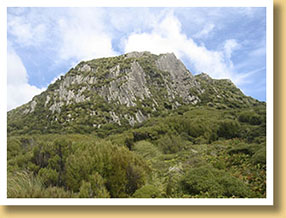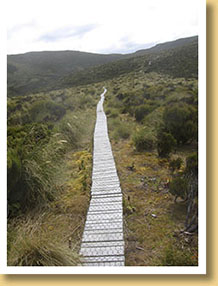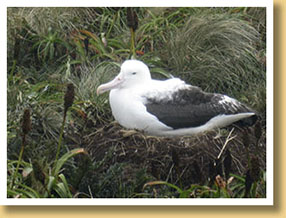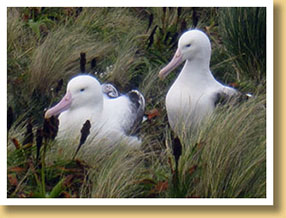
 "We stopped at Campbell Island, which was not on our itinerary but was on our path to New Zealand towards the end of the trip and they did want us have the chance to visit one of the isolated sub-Antarctic Islands about 300 miles south of New Zealand in the "Screaming 50s" in terms of the Southern Ocean.
"We stopped at Campbell Island, which was not on our itinerary but was on our path to New Zealand towards the end of the trip and they did want us have the chance to visit one of the isolated sub-Antarctic Islands about 300 miles south of New Zealand in the "Screaming 50s" in terms of the Southern Ocean.
After weeks of blue ocean, mostly gray sky and white ice, we suddenly found ourselves starring at soaring deep green peaks with a narrow ocean channel cut through them to where we could anchor near the center of the island. Today, the goal was to cross the mountains to get a view of the steep cliffs on the other side. The landing was very calm,  and off we went along prepared trails that were on three foot wide boards held together with chicken wire. The path was created to keep us off of the vegetation which is extraordinarily fragile. This is an island that gets fewer than 300 to 400 visitors a year.
and off we went along prepared trails that were on three foot wide boards held together with chicken wire. The path was created to keep us off of the vegetation which is extraordinarily fragile. This is an island that gets fewer than 300 to 400 visitors a year.
The hike lasted from 12:00 to 5:00, so we walked five hours up and over a modestly difficult ridge, across a saddle and up to the top where we could see the cliffs on the opposite side of the island. None of this, however, was the extraordinary part of this trip. As we move along, we began seeing white spots on the mountain sides around us. The spots turned out to be albatrosses sitting on their nests. We have been seeing them soaring around our ship since we entered the south ocean. They apparently have the widest wing span of any bird in existence. Seen from the ship, they look like really skilled sea gulls. However, our trip hike took us within a few feet of several of the nests, each with an albatross warming an egg. Our guides made sure we did not get too close so as to not disturb the birds too much. These birds are so unused to  humans they do not see us as a threat so they essentially ignored us. What was incredible was to see that these creatures are gigantic. Think of a sea gull, multiply by ten and you have an albatross. They are huge, bigger than turkeys. No wonder they have such a large wing span to keep them in the air. What is amazing after being up close to them is to recognize that these are the same birds that have been gliding up and down near the wave tops and around our ship without ever once flapping their wings.
humans they do not see us as a threat so they essentially ignored us. What was incredible was to see that these creatures are gigantic. Think of a sea gull, multiply by ten and you have an albatross. They are huge, bigger than turkeys. No wonder they have such a large wing span to keep them in the air. What is amazing after being up close to them is to recognize that these are the same birds that have been gliding up and down near the wave tops and around our ship without ever once flapping their wings.
Our ornithologists told us that these birds pick a mate during the "summer" which is now. They do not mate right away as winter is approaching and a chick would not survive. Essentially, they make a date to meet at the site of a nest here on Campbell Island in December, 10 months from now at the start of the southern summer. The male and female then cruise all around the Southern Ocean on their own, covering thousands of miles. The male comes early and refreshes the nest. The female arrives, agrees and they mate, produce an egg which each of the pair takes care of. When the chick is born,  the pair stays and alternates in staying with the chick and going out to sea to gather food to feed it. We saw one pair with one giant bird on the egg and the other staying to take his or her turn on it. The waiting bird then moved into nesting position on its own and began pulling up twigs and grasses as if to make a second nest or to replenish the one where the mate was sitting.
the pair stays and alternates in staying with the chick and going out to sea to gather food to feed it. We saw one pair with one giant bird on the egg and the other staying to take his or her turn on it. The waiting bird then moved into nesting position on its own and began pulling up twigs and grasses as if to make a second nest or to replenish the one where the mate was sitting.